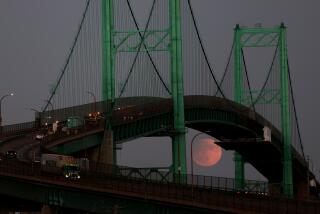Nature Offers Little Help in Seeing Eclipse : Astronomy: Haze fails to frustrate view from CSUN solar observatory.
SYLMAR — A blanket of haze Tuesday mocked eclipse watchers, who found that their telescopes and pinhole contraptions were of little help in viewing what astronomers said would be the area’s last visible solar eclipse this century.
So while most of the San Fernando Valley had trouble even telling in which direction the sun was shining, a small group of would-be astronomers gathered at Cal State Northridge’s solar observatory in Sylmar that sank three inches during the Jan. 17 quake, rendering its two largest telescopes inoperable.
Using two refracting telescopes mounted with cameras and a 3-inch Cartesian full-disc telescope, astronomy professor Stephen Walton and a handful of students and technicians who had seen many eclipses quietly watched as maximum eclipse was reached at 9 a.m., when 72% of the surface was obscured by the moon.
“This is nice,” astrophysics student Chris Mach, 25, of Los Angeles remarked dispassionately as he photographed one of the sun’s prominences: eruptions of gaseous material that can stretch hundreds of thousands of miles above the sun’s surface.
The group’s research helped them test the accuracy of the telescopes in measuring sunspots, areas of intense magnetic activity on the sun’s surface that Walton said may be associated with changing weather patterns on Earth.
The non-experts among the observers just wanted to know what they were seeing. “So that big, round black thing . . . that’s the moon right there?” asked a Department of Water and Power worker who spent his coffee break observing the eclipse through one of the small telescopes.
Meanwhile, on the CSUN campus, some were hardly interested at all. “It comes on TV and that’s safer anyway,” said Dalila Valenzuela, 20, sitting on a fog-shrouded patio outside the campus bookstore.
“You can’t see it anyway, so why bother?” said student Jim Marshall, who dozed in his car during the apex of the eclipse, while waiting for his class to start.
Scientists say it wasn’t Los Angeles but El Paso, Tex., that should have been one of the nation’s stellar viewing locations Tuesday. It is within a 150-mile band stretching from Baja California to New England where the moon blotted out all but the sun’s fiery rim.
But visible locally or not, the eclipse was loaded with significance for Valley astrologers, who said 20% of it was located in the constellation Taurus.
“This is really a fiery new beginning,” said Helene Cushman, a Tarzana astrologer whose telephone directory ad lists her as a consultant, teacher and lecturer on the subject for 25 years. “There should be more energy associated with this one . . . more people starting new businesses. It should be positive for people who know how to harness that energy, but for those who can’t control their tempers or who drive too fast, it could be negative.”
Charlene Whitaker, who has been practicing astrology for 20 years in Canoga Park, said that while lunar eclipses are symbolic of dying and diminishing, solar eclipses bring with them periods of increasing or adding. But that is not always positive.
“Eclipses do set things in motion,” she said. “People get a little antsy. The last (solar eclipse, in 1993) was partly responsible for the (Northridge) earthquake, but this one is going to be a lot better.”
At Chaminade High School in West Hills, science teacher Dave Reeves and about 100 students battled the gloom with reflecting telescopes and telescopes mounted with cameras for about an hour before finally giving up.
“It was pretty good until the cloud came by,” said Reeves.
In the end, a few of his students even moved on to Simi Valley in search of sunnier skies.
Cloudless blue skies in the Antelope Valley created some of the best viewing conditions in Southern California, but that didn’t mean everyone in the high desert was consumed by the eclipse.
“I missed it,” said Palmdale resident Paul Heindel. “I was in a meeting, I think. I can’t remember.”
Heindel said he did not make a point of seeing the eclipse because “I’ve seen them.”
At the Antelope Valley Fair in Lancaster, several employees did venture outside to watch the sun all but disappear in the shadow of the moon. But not all of them actually got a chance to witness the celestial event.
Fair Manager Bruce Latta said, “I went outside and stood under a tree and talked to someone and never looked up. I didn’t have anything to look through.”
Employees at NASA’s Dryden Flight Research Center didn’t have to worry about protecting their eyes with welder’s goggles or other filters because the eclipse was carried on the space agency’s in-house television system, NASA TV.
Cameras in five locations across the country--including the Jet Propulsion Laboratory in Pasadena, the Johnson Space Center in Houston and the Kennedy Space Center in Florida--provided views of the eclipse to NASA employees and anyone with a satellite able to pick up NASA TV.
At the Griffith Observatory, a traditional Los Angeles gathering spot for observing astronomical phenomena, eye protection was also the furthest thing from the minds of the 800 or so who showed up to view the eclipse. Solar sunglass salesman Roger Harrison of Glendora said he had sold fewer than 30 of his $4 smoky lenses.
When told that the next solar eclipse would not be visible in the United States until 2012, he promised, “I’ll be back.”
Times staff writer Bob Pool and special correspondent Sharon Moeser contributed to this story.






